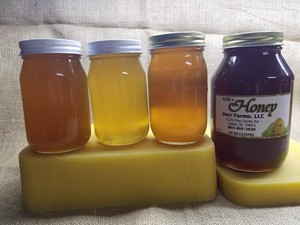Tupelo Honey
 Tupelo honey is produced when honeybees collect nectar from the blossoms of the white Ogeechee tupelo (Nyssa ogeche) tree. These trees are distributed along the borders of rivers, swamps, and ponds that are frequently inundated, mainly in the remote wetlands of Georgia and Florida. Tupelo honey is said to come from trees along just a few rivers, the most prominent (and generally agreed upon) being the Apalachicola and Ochlockonee rivers.
Tupelo honey is produced when honeybees collect nectar from the blossoms of the white Ogeechee tupelo (Nyssa ogeche) tree. These trees are distributed along the borders of rivers, swamps, and ponds that are frequently inundated, mainly in the remote wetlands of Georgia and Florida. Tupelo honey is said to come from trees along just a few rivers, the most prominent (and generally agreed upon) being the Apalachicola and Ochlockonee rivers.
Tupelo trees have clusters of inconspicuous greenish flowers, which later develop into berrylike fruits. The bloom lasts a mere 2-3 weeks in April and May. Pure tupelo honey is light amber in color; some note a green cast. It has a pear-like and hoppy aroma and a coveted flavor that fans describe as mild, delicate, buttery, floral, like cotton candy and like rosewater.
Because of its unusually high fructose content (versus sucrose), tupelo honey will not granulate. A granulated tupelo honey indicates an impure tupelo honey. Also because of its low sucrose content, some diabetics may eat it. Certified tupelo honey is not heated, processed, or filtered; neither is it mixed in any amount with honey procured from other blossoms. Even a slight amount of another honey (gallberry honey, which is harvested just before tupelo, is the most common interloper) is not tolerated in pure tupelo honey.
The white tupelo tree grows naturally in southeastern swamps. Because of the trees' brief flowering time, beekeepers must be precise about getting bees to the trees; often this is accomplished by housing the bees on remote docks that are only accessible by boat. The strictly regional nature of tupelo honey dictates that its production exists in a tiny subculture. The beekeeper George Watkins says that he is the only tupelo honey producer currently harvesting from trees along the Apalachicola River.
A variety of elements contribute to the limited production and possibility of extinction of tupelo honey:
- Short (2-3 week) harvest season, which can be further reduced by poor weather conditions.
- Labor-intensive and stressful harvest requiring precise timing and special equipment?beekeepers must manage bees continually, usually from boats in hot and remote areas, during the harvest. Before the harvest, bees must be stripped of any other honey.
- Insecticides. On their website, the Lanier family of beekeepers reported the following about the 2005 season: ?We would have had a bumper crop if it hadn't been for the county mosquito control. The mosquito control was running a daylight route and sprayed our bees in flight in the middle of the tupelo flow killing them on the spot.?
- Development. The area of the Gulf Coast around Apalachicola is currently undergoing a major and well-documented development boom, largely thanks to the St. Joe Company, which owns miles upon miles of coastline. One could say that all plant and animal species in the region (including the native working class of humans) are endangered.
- Imports. During an oral history interview conducted by the Southern Foodways Alliance, the beekeeper George Watkins of Apalachicola, Florida, said that tupelo honey, which sells at a higher price than other honeys, keeps him in business: ?And if it wasn't for the tupelo, though, I don't think we could make it as a beekeeper around here because of the imports?they bring in this cheap Chinese honey and Mexican honey, Vietnam honey. We know that's where it's coming from because they give us the old barrels to put our honey in.? (Later in the interview, he remembers the large amounts of honey imported from Argentina as well.) Fortunately, there is enough demand for tupelo honey to keep him in the black for now.

First photo courtesy of Gina Fiorillo
Second photo courtesy of Amy Evans


